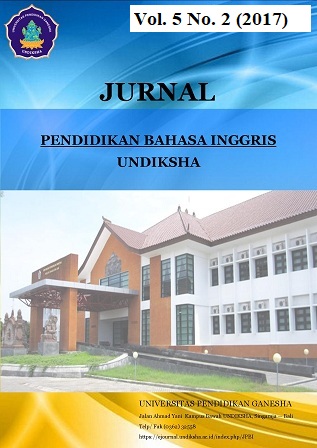DEVELOPING A STANDARD ENGLISH LANGUAGE FINAL ACHIEVEMENT TEST INSTRUMENT FOR TENTH GRADE STUDENTS IN BANGLI AND BULELENG REGENCY IN 2014/2015 ACADEMIC YEAR BASED ON CURRICULUM 2013
DOI:
https://doi.org/10.23887/jpbi.v5i2.11257Abstract
Penelitian ini merupakan jenis penelitian dan pengembangan (R&D) yang didasari oleh model penelitian dan pengembangan yang digagas oleh Borg dan Gall (2003). Penelitian ini bertujuan untuk mengembangkan sebuah tes akhir prestasi belajar siswa kelas 10 dalam mata pelajaran Bahasa Inggris, terutama dalam pemahaman membaca, yang standar berdasarkan kurikulum 2013. Subyek dari penelitian ini ialah para siswa di kelas XI MIA 1 di SMA Negeri 2 Singaraja di Kabupaten Buleleng dan para siswa di kelas XI MIA 2 di SMA Negeri 1 Bangli di Kabupaten Bangli. Obyek dari penelitian ini adalah 100 soal yang berbentuk soal pilihan ganda yang diteskan kepada para siswa di kedua sekolah tersebut. Adapun langkah-langkah yang diterapkan dalam pengembangan tes ini yaitu (1) penelitian dan pengumpulan informasi, (2) perencanaan, (3) pengembangan produk awal, (4) uji coba awal sebelum diteskan kepada siswa, (5) perbaikan dari produk awal, (6) uji coba dengan melibatkan siswa, (7) perbaikan dari produk awal menjadi produk akhir. Soal-soal diteskan di dua kelas tersebut dan hasil dari tes dianalisa dengan mempergunakan program Anates versi 4.0 mengenai validitas soal, reliabilitas, daya pembeda, tingkat kesukaran, homogenitas, dan daya pengecoh dari pilihan jawaban soal. Hasil dari penelitian ini berupa buku bank soal yang mana dari 100 soal terdapat 64 soal yang dikategorikan sebagai soal yang valid dan standar di Kabupaten Bangli dan Kabupaten Buleleng.Kata Kunci : Penelitian dan Pengembangan (R&D), pemahaman membaca, tes standar, validasi
This research is a research and development (R&D) following the R&D model proposed by Borg and Gall (2003). This research aimed at developing a Standard English Language final achievement test, specifically about the reading comprehension, for tenth grade students based on curriculum 2013. The subject of this study were the students of Class XI MIA 1 in SMA Negeri 2 Singaraja in Buleleng Regency and the students in Class XI MIA 2 in SMA Negeri 1 Bangli in Bangli Regency. The object of the study were 100 test items in form of multiple-choice test that were tested to the students in the two schools. The steps taken to develop the test were (1) research and information collection, (2) planning, (3) develop preliminary form of product, (4) Preliminary field testing, (5) main product revision, (6) main field testing, and (7) operational product revision. The test items were tried-out in the two classes and the results were analyzed by using Anates 4.0 version application in term of validity, reliability, index of discrimination, index of faculty, homogeneity and the quality of distractor. The result of the study was the final product of test in form of bank question book where from 100 items, there were 64 items considered as valid and standard in both Bangli and Buleleng Regencies.
keyword : R&D, reading comprehension, standard test, validation
Published
2017-07-26
Issue
Section
Articles
License
Authors who publish with the Jurnal Pendidikan Bahasa Inggris Undiksha agree to the following terms:- Authors retain copyright and grant the journal the right of first publication with the work simultaneously licensed under a Creative Commons Attribution License (CC BY-SA 4.0) that allows others to share the work with an acknowledgment of the work's authorship and initial publication in this journal
- Authors are able to enter into separate, additional contractual arrangements for the non-exclusive distribution of the journal's published version of the work (e.g., post it to an institutional repository or publish it in a book), with an acknowledgment of its initial publication in this journal.
- Authors are permitted and encouraged to post their work online (e.g., in institutional repositories or on their website) prior to and during the submission process, as it can lead to productive exchanges, as well as earlier and greater citation of published work. (See The Effect of Open Access)













